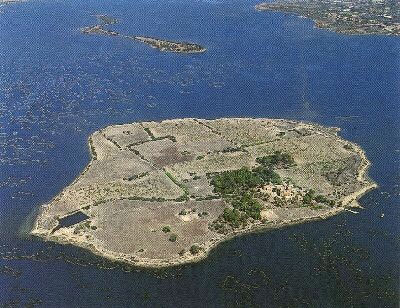Mozia


Davanti la costa marsalese, nella zona delle saline, alcune piccole isole si stringono a formare una laguna: è la Riserva Naturale Orientata Isole dello Stagnone. Tra queste, la più importante è sicuramente Mozia.
Il suo ruolo nella storia non è indifferente, tanto che per la sua posizione strategica nel Mediterraneo, i Cartaginesi ne vollero fare un proprio scalo commerciale. Purtroppo però Mozia subì le conseguenze della lotta tra Greci e Cartaginesi per il dominio sulla Sicilia. Quando fu attaccata e distrutta da Dionisio di Siracusa, i suoi abitanti si trasferirono sul promontorio antistante, dove sorse l’odierna Marsala.
I resti della sua civiltà e della sua florida attività economica sono stati riportati alla luce da una lunga serie di scavi archeologici, soprattutto grazie all’opera dell'industriale vinicolo inglese Joseph Whitaker, che aveva precedentemente acquistato l’isola.
In quella che fu la sua casa oggi ha sede il Museo che raccoglie i reperti portati alla luce durante le diverse campagne di scavo. Un plastico vi mostrerà innanzitutto l’intera isola di Mozia, in modo da individuare più facilmente i siti di maggiore rilievo storico.
Il Museo conserva una gran quantità di reperti di epoca preistorica, materiali rinvenuti nell’abitato, arredi funerari provenienti dal Tophet e dalla necropoli arcaica, ceramiche, monete, sculture, gioielli e steli votive.
Grande vanto dell’isola, è il famoso Giovinetto di Mozia.
La statua in marmo bianco dell’Anatolia, alta 1,81 m, manca degli arti. Molti sono ancora i dubbi riguardo l’origine e il soggetto rappresentato. La tunica e la complessa acconciatura fanno comunque pensare ad un soggetto di alto rango. L’autore, se non greco, fu comunque influenzato dallo “stile severo” greco e possedeva un senso plastico non comune. Le proporzioni sono armoniose ed eleganti. Molto bella la tunica pieghettata e ben disegnata sul corpo. Probabilmente risale al V sec. a.C.
L’isola è facilmente percorribile a piedi ed in poco meno di un'ora si compie il completo periplo che vi porterà ad ammirare numerosi siti archeologici, tra i quali:
La Casa dei Mosaici: due mosaici del IV sec. a.C. formati da ciottoli bianchi e neri che raffigurano scene di lotta tra animali.
Il Cothon: piccolo bacino di carenaggio dalla forma rettangolare.
Resti di fortificazioni: nonostante la sua posizione geografica fosse già una protezione naturale, a partire dalla metà del IV sec. e tramite interventi successivi, la città venne cinta di mura. Se ne vedono alcuni resti a Nord e a Sud. Sono visibili anche alcune delle torri collocate lungo il perimetro.
Il Santuario di Cappidazzu: l’area comprende costruzioni di varie epoche di cui è ancora sconosciuto l’utilizzo. La presenza di alcuni altari fa pensare comunque ad un luogo sacro destinato alle offerte per le divinità.
Il Tophet: area sacra dov’erano sacrificati agli dei i primogeniti maschi. Qui sono state ritrovate numerose stele votive.

This tiny island just off the coast north of Marsala was once the home of the Phoenician colony that was expelled in 379 BC and founded Lilibeo (Marsala). The island's role in the events of Sicily's early Phoenician period (before 600 BC) far transcended its diminutive size. The Phoenicians were a seafaring Semitic people from what is now Syria and Lebanon; they founded Carthage and other Mediterranean coastal communities, such as Motia. Therefore, it was only natural that Motia, and then Lilibeo, should side with Carthage in the wars against the Greeks. Ironically, the Greeks themselves owed much, including a great deal of their language and alphabet, to the early Phoenicians, despite their later political differences with the Carthaginians.
The island of Mozia, which is owned and operated by a foundation established by the winemaking Whitaker family (who built the Anglican Church and Villa Malfitano in Palermo), has a remarkable museum and the ruins of an equally remarkable civilization, complete with a harbor and cemetery. Some of the finds on display in the museum have a distinctly Egyptian influence, while others seem almost Hellenic. Though certain of these items were brought to Motia from Asia Minor, others were made locally, based on "foreign" influences. Mozia and its unique museum provide the visitor with a rare unspoiled glimpse into Sicily's Phoenician past.
Mothia itself was founded before 700 BC on the island now known as San Pantaleo in a large lagoon ("Stagnone"). Mothia emerged as one of the most prosperous colonies of the Phoenicians' loose Mediterranean confederation. The more noteworthy features are the fortifications, a submerged road that used to link the island to the mainland, near Birgi, the cothon (or drainage basin and harbour) and the main sanctuaries, in particular the tophet, where the burnt remains of offerings and sacrifices in honour of the god Baal Hammon were collected. Thousands of carved steles where discovered here, and these are the most convincing evidence of Punic sculpture. The most ancient part of old Mozia's industrial area includes several semicircular furnaces, identical in construction to the more ancient pottery furnaces used in Phoenicia.
Historians generally agree that the most more violent attacks of the Syracusan army probably occurred near the northern gate, ending in defeat and plunder in 397 BC.
For Visitors: Visitors with particular culinary interests seem to expect a certain local mystique when they come to the place where the world's most famous cooking wine is made. (Marsala wine is also served with desserts.) Though its restaurants offer some excellent cuisine to complement this distinguished wine, the city of Marsala could not be described as particularly exciting. Some of the wineries give occasional tours.